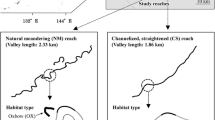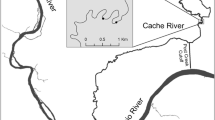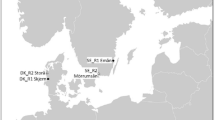Abstract
This study evaluated the use by fish of restored tidal wetlands and identified links between fish species composition and habitat characteristics. We compared the attributes of natural and constructed channel habitats in Sweetwater Marsh National Wildlife Refuge, San Diego Bay, California, by using fish monitoring data to explore the relationships between channel environmental characteristics and fish species composition. Fishes were sampled annually for 8 yr (1989–1996) at eight sampling sites, four in constructed marshes and four in natural marshes, using beach seines and blocking nets. We also measured channel habitat characteristics, including channel hydrology (stream order), width and maximum depth, bank slope, water quality (DO, temperature, salinity), and sediment composition. Fish colonization was rapid in constructed channels, and there was no obvious relationship between channel age and species richness or density. Total richness and total density did not differ significantly between constructed and natural channels, although California killifish (Fundulus parvipinnis) were found in significantly higher densities in constructed channels. Multivariate analyses showed fish assemblage composition was related to channel habitat characteristics, suggesting a channel’s physical properties were more important in determining fish use than its restoration status. This relationship highlights the importance of designing restoration projects with natural hydrologic features and choosing proper assessment criteria in order to avoid misleading interpretations of constructed channel success. We recommend that future projects be designed to mimic natural marsh hydrogeomorphology and diversity more closely, the assessment process utilize better estimates of fish habitat function (e.g., individual and community-based species trends, residence time, feeding, growth) and reference site choice, and experimental research be further incorporated into the restoration process.
Similar content being viewed by others
Literature Cited
Allen, E. B., W. W. Covington, andD. A. Falk. 1997. Developing the conceptual basis for restoration ecology.Restoration Ecology 5:275–276.
Allen, L. G. 1982. Seasonal abundance, composition, and productivity of the littoral fish assemblage in upper Newport Bay, California.Fishery bulletin, United States 80:769–789.
Allen, L. G. 1985. A habitat analysis of the nearshore marine fishes from southern California.Bulletin of the Southern California Academy of Sciences 84:133–155.
Baltz, D. M., C. Rakocinski, andJ. W. Fleeger. 1993. Microhabitat use by marsh-edge fishes in a Louisiana estuary.Environmental Biology of Fishes 36:109–126.
Bell, S. S., M. S. Fonseca, andL. B. Motten. 1997. Linking restoration and landscape ecology.Restoration Ecology 5:318–323.
Boesch, D. F. andR. E. Turner. 1984. Dependence of fishery species on salt marshes: The role of food and refuge.Estuaries 7:460–468.
Bortone, S. A. andJ. J. Kimmel. 1991. Environmental assessment and monitoring of artificial habitats, p. 177–234.In W. Seaman and L. M. Sprague (eds.), Artificial Habitats for Marine and Freshwater Fisheries. Academic Press, Inc., San Diego, California.
Brinson, M. M. andR. Rheinhardt. 1996. The role of reference wetlands in functional assessment and mitigation.Ecological Applications 6:69–76.
Brothers, E. B. 1975. The comparative ecology and behavior of three sympatric California gobies. Ph.D. Dissertation, University of California, San Diego, California.
Carpelan, L. H. 1961. Salinity tolerances of some fishes of a southern California coastal lagoon.Copeia 1:32–39.
Chambers, J. R. 1992. Coastal degradation and fish population losses, p. 45–51.In R. H. Stroud (ed.), Stemming the Tide of Coastal Fish Habitat Loss. National Coalition for Marine Conservation, Inc., Savannah, Georgia.
Clark, B. M., B. A. Bennett, andS. J. Lamberth. 1996. Factors affecting spatial variability in seine net catches of fish in the surf zone of False Bay, South Africa.Marine Ecology Progress Series 131:17–34.
Coats, R., M. Swanson, andP. Williams. 1989. Hydrologic analysis for coastal wetland restoration.Environmental Management 13:715–727.
Desmond, J. S., G. D. Williams, and J. B. Zedler. In press. Fish use of tidal creek habitats in two southern California saltmarshes.Ecological Engineering.
Ehrenfeld, J. G. andL. A. Toth. 1997. Restoration ecology and the ecosystem perspective.Restoration Ecology 5:307–317.
Emmett, R. L., S. L. Stone, S. A. Hinton, andM. E. Monaco. 1991. Distribution and Abundance of Fishes and Invertebrates in West Coast Estuaries, Volume II. Species Life History Summaries. Estuarine Living Marine Resources Program Report. No. 8. National Oceanic and Atmospheric Administration, National Ocean Survey, Strategic Environmental Assessments Division, Rockville, Maryland.
Everts, C. H. 1980. A method to Predict the Stable Geometry of a Channel Connecting an Enclosed Harbor and Navigable Waters. United States Army Corps of Engineers Coastal Engineering Research Center Technical Paper No. 80-6. Ft. Belvoir, Virginia.
Fausch, K. D., J. Lyons, J. R. Karr, andP.L. Angermeier. 1990. Fish communities as indicators of environmental degradation, p. 123–144.In S. M. Adams (ed.), Biological Indicators of Stress in Fish. American Fisheries Society, Bethesda, Maryland.
Field, D. W., A. J. Refer, P. V. Genovese, andB. D. Shearer. 1991. Coastal Wetlands of the United States: An Accounting of a Valuable National Resource. National Oceanic and Atmospheric Administration and United States Fish and Wildlife Service, Department of Commerce, Washington, D.C.
Frey, R. W., andP. B. Bason. 1985. Coastal salt marshes, p. 225–301.In R. A. Davis (ed.), Coastal Sedimentary Environments. Springer-Verlag, New York.
Fritz, E. S.. 1975. The life history of the California killifishFundulus parvipinnis Girard in Anaheim Bay, California, p. 91–106.In E. D. Lane, and C. W. Hill (eds.), The Marine Resources of Anaheim Bay. Fish Bulletin 165. California Department of Fish and Game, Sacramento, California.
Garofalo, D. 1980. The influence of wetland vegetation on tidal stream channel migration and morphology.Estuaries 3:258–270.
Gee, G. W. andJ. W. Bauder. 1986. Particle-size analysis, p. 383–411.In Methods of Soil Analysis, Part 1. Physical and Mineralogical Methods. American Society of Agronomy, Madison, Wisconsin.
Gibson, K. D., J. B. Zedler, andR. Langis. 1994. Limited response of cordgrass (Spartina foliosa) to soil amendments in a constructed marsh.Ecological Applications 4:757–767.
Gorman, O. T., andJ. R. Karr. 1978. Habitat structure and stream fish communities.Ecology 59:507–515.
Haltiner, J., J. B. Zedler, K. E. Boyer, G. D. Williams, andJ. Callaway. 1997. Influence of physical processes on the design, functioning, and evolution of restored tidal wetlands in California (USA).Wetlands Ecology and Management 4:73–91.
Harris, J. H.. 1995. The use of fish in ecological assessments.Australian Journal of Ecology 20:65–80.
Havens, K. J., L. M. Varnell, andJ. G. Bradshaw. 1995. An assessment of ecological conditions in a constructed tidal marsh and two natural reference tidal marshes in coastal Virginia.Ecological Engineering 4:117–141.
Hixon, M. A., andJ. P. Beets. 1993. Predation, prey refuges, and the structure of coral-reef fish assemblages.Ecological Monographs 63:77–101.
Horn, M., andL. Allen. 1985. Fish community ecology in southern California bays and estuaries, p. 169–190.In A. Yañez-Arancibia (ed.), Fish Community Ecology in Estuaries and Coastal Lagoons: Toward an Ecosystem Integration. Universidad National Autonoma de Mexico Press México, Ciudad Universitaria, México.
Johnson, J. M.. 1999. Fish Use of a Southern California Salt Marsh. M.S. Thesis, San Diego State University, San Diego, California.
Karr, J. R. 1981. Assessment of biotic integrity using fish communities.Fisheries 6:21–27.
Karr, J. R.. 1987. Biological monitoring and environmental assessment: A conceptual framework.Environmental Management 11:249–256.
Kentula, M. E., R. P. Brooks, S. E. Gwin, C. C. Holland, A. D. Sherman, andJ. C. Sifneos. 1992. An approach to improving decision making in wetland restoration and creation. United States Environmental Protection Agency, Environmental Research Laboratory, Corvallis, Oregon.
Kirchhofer, A.. 1995. Morphological variability in the ecotone—An important factor for the conservation of fish species richness in Swiss rivers.Hydrobiologia 303:103–110.
Kusler, J. A., andM. E. Kentula. 1990. Wetland Creation and Restoration: The Status of the Science, Volume 1. Regional Reviews. EPA/600/3-89/038a. United States Environmental Protection Agency, Environmental Research Laboratory, Corvallis, Oregon.
Kwak, T. J., andJ. B. Zedler. 1997. Food web analysis of southern California coastal wetlands using multiple stable isotopes.Oecologia 110:262–277.
Langis, R., M. Zalejko, andJ. B. Zedler. 1991. Nitrogen assessments in a constructed and natural salt marsh of San Diego Bay.Ecological Applications 1:40–51.
MacDonald, K. B.. 1990. South San Diego Bay Enhancement Plan, Volume 1. Resources Atlas. Marine Ecological Characterization, Bay History, and Physical Environment. San Diego Unified Port District, San Diego, California.
Magurran, A. E. 1988. Ecological Diversity and Its Measurement. Princeton University Press, Princeton, New Jersey.
McHugh, J. L. 1966. Management of estuarine fishes, p. 133–154.In R. F. Smith, A. H. Swartz, and W. H. Massman (eds.), A Symposium on Estuarine Fisheries. American Fisheries Society Special Publication. No. 3. Allen Press, Inc., Lawrence, Kansas.
McIvor, C. C., andW. E. Odum. 1988. Food, predation risk, and microhabitat selection in a marsh fish assemblage.Ecology 69:1341–1351.
Meffe, G. K. andA. L. Sheldon. 1988. The influence of habitat structure on fish assemblage composition in southeastern blackwater streams.American Midland Naturalist 120:225–240.
Meng, L., P. B. Moyle, andB. Herbold. 1994. Changes in abundance and distribution of native and introduced fishes of Suisun Marsh.Transactions of the American Fisheries Society 123:498–507.
Miller, D. J. andR. N. Lea. 1972. Guide to the coastal marine fishes of California. Fish Bulletin 157. California Department of Fish and Game, Sacramento, California.
Miller, J. A. andC. A. Simenstad. 1997. A comparative assessment of a natural and created estuarine slough as rearing habitat for juvenile chinook and coho salmon.Estuaries 20:792–806.
Minello, T. J. andJ. W. Webb. 1997. Use of natural and createdSpartina alterniflora salt marshes by fishery species and other aquatic fauna in Galveston Bay, Texas, USA.Marine Ecology Progress Series 151:165–179.
Minello, T. J. andR. J. Zimmerman. 1992. Utilization of natural and transplanted Texas salt marshes by fish and decapod crustaceans.Marine Ecology Progress Series 90:273–285.
Minello, T. J., R. J. Zimmerman, andR. Medina. 1994. The importance of edge for natant macrofauna in a created salt marsh.Wetlands 14:184–198.
Mitsch, W. J. andJ. G. Gosselink. 1993. Wetlands, 2nd edition. Van Nostrand Reinhold, New York.
Moy, L. D. andL. A. Levin. 1991. AreSpartina marshes a replaceable resource? A functional approach to evaluation of marsh creation efforts.Estuaries 14:1–16.
Moyle, P. B. andT. Light. 1996. Biological invasions of fresh water: Empirical rules and assembly theory.Biological Conservation 78:149–161.
Mudie, P. J. 1970. A survey of the coastal wetland vegetation of San Diego Bay, Part I. Description of the environment and the vegetation types. Contract # W26 D25-51. California Department of Fish and Game, Sacramento, California.
National Oceanic and Atmospheric Administration. 1990. Estuaries of the United States: Vital Statistics of a National Resource Base. Special 20th Anniversary Report. Rockville, Maryland.
Nordby, C. S. andJ. B. Zedler. 1991. Responses of fish and macrobenthic assemblages to hydrologic disturbances in Tijuana Estuary and Los Peñasquitos Lagoon, California.Estuaries 14:80–93.
Onuf, C. P. andM. L. Quammen. 1983. Fishes in a California coastal lagoon: Effects of major storms on distribution and abundance.Marine Ecology Progress Series 12:1–14.
Onuf, C. P., M. L. Quammen, G. P. Shaffer, C. H. Peterson, J. W. Chapman, J. Cermak, andR. W. Holmes. 1979. An analysis of the values of central and southern California coastal wetlands, p. 186–199.In P. E. Greeson, J. R. Clark, and J. E. Clark (eds.), Wetland Functions and Values: The State of Our Understanding. American Water Resources Association, Minneapolis, Minnesota.
Paller, M. H. 1994. Relationships between fish assemblage structure and stream order in South Carolina coastal plain streams.Transactions of the American Fisheries Society 123:150–161.
Palmer, M. A., R. F. Ambrose, andN. L. Poff. 1997. Ecological theory and community restoration ecology.Restoration Ecology 5:291–300.
Pearcy, W. G. andS. S. Myers. 1974. Larval fishes of Yaquina Bay, Oregon: A nursery ground for marine fishes?Fishery Bulletin, United States 72:201–213.
Peterson, G. W. andR. E. Turner. 1994. The value of salt marsh edge vs. interior as a habitat for fish and decapod crustaceans in a Louisiana tidal marsh.Estuaries 17:235–262.
Piepenburg, D. andU. Piatkowski. 1992. A program for computer-aided analyses of ecological field data.CABIOS 8:587–590.
Rozas, L. P., C. C. McIvor, andW. E. Odum. 1988. Intertidal rivulets and creekbanks: Corridors between tidal creeks and marshes.Marine Ecology Progress Series 47:303–307.
Ruiz, G. M., A. H. Hines, andM. H. Posey. 1993. Shallow water as a refuge habitat for fish and crustaceans in non-vegetated estuaries: An example from Chesapeake Bay.Marine Ecology Progress Series 99:1–16.
Sebens, K. P. 1991. Habitat structure and community dynamics in marine benthic systems, p. 211–234.In S. S. Bell, E. D. McCoy, and H. R. Mushinsky (eds.), Habitat Structure: The Physical Arrangement of Objects in Space. Chapman and Hall, New York.
Shreffler, D. K., C. A. Simenstad, andR. M. Thom. 1990. Temporary residence by juvenile salmon of a restored estuarine wetland.Canadian Journal of Fisheries and Aquatic Sciences 47:2079–2084.
Shreffler, D. K., C. A. Simenstad, andR. M. Thom. 1992. Juvenile salmon foraging in a restored estuarine wetland.Estuaries 15:204–213.
Simenstad, C. A., C. D. Tanner, R. M. Thom, andL. L. Conquest. 1991. Estuarine Habitat Assessment Protocol. United State Environmental Protection Agency, Seattle, Washington.
Simenstad, C. A. andR. M. Thom. 1996. Functional equivalency trajectories of the restored Gog-le-hi-te estuarine wetland.Ecological Applications 6:38–56.
Strahler, A. N. 1964. Quantitative geomorphology of drainage basins and channel networks, p. 34–76.In V. T. Chow (ed.), Handbook of Applied Hydrology. McGraw-Hill, New York.
Streever, W. J. andK. M. Portier. 1994. A computer program to assist with sampling design in the comparison of natural and constructed wetlands.Wetlands 14:199–205.
Swift, C. C., T. R. Haglund, M. Ruiz, andR. N. Fisher. 1993. The status and distribution of the freshwater fishes of southern California.Bulletin of the Southern California Academy of Sciences 92:101–167.
Swift, C. C., J. L. Nelson, C. Maslow, andT. Stein. 1989. Biology and Distribution of the Tidewater Goby,Eucyclogobius newberryi (Pisces: Gobiidae) of California. Contributions in Science No. 404. Natural History Museum of Los Angeles County, Los Angeles, California.
SYSTAT, Inc. 1992. Statistics, Version 5.2 Edition. SYSTAT, Inc., Evanston, Illinois.
ter Braak, C. J. F. 1988. CANOCO—A FORTRAN program for Canonical Community Ordination. Microcomputer Power, Ithaca, New York.
ter Braak, C. J. F. andP. F. M. Verdonschot. 1995. Canonical correspondence analysis and related multivariate methods in aquatic ecology.Aquatic Sciences 57:255–289.
Thayer, G. W., J. P. Thomas, andK. V. Koski. 1996. The habitat research plan of the National Marine Fisheries Service.Fisheries 21:6–10.
Todd, E. S. andA. W. Ebeling. 1966. Aerial respiration in the longjaw mudsuckerGillichthys mirabilis (Teleostei: Gobiidae).Biological Bulletin 130:265–288.
Trexler, J. C. 1995. Restoration of the Kissimmee River: A conceptual model of past and present fish communities and its consequences for evaluating restoration success.Restoration Ecology 3:195–210.
Underwood, A. J. 1981. Techniques of analysis of variance in experimental marine biology and ecology.Oceanography and Marine Biology Annual Review 19:513–605.
Vose, F. E. andS. S. Bell. 1994. Resident fishes and macrobenthos in mangrove-rimmed habitats: Evaluation of habitat restoration by hydrologic modification.Estuaries 17:585–596.
Weinstein, M. P. 1979. Shallow marsh habitats as primary nurseries for fishes and shellfish, Cape Fear River, North Carolina.Fishery Bulletin, United States 77:339–357.
Yoklavich, M. M., G. M. Caillet, J. P. Barry, D. A. Ambrose, andB. S. Antrim. 1991. Temporal and spatial patterns in abundance and diversity of fish assemblages in Elkhorn Slough, California.Estuaries 14:465–480.
Zar, J. H. 1984. Biostatistical Analysis. Prentice-Hall, Inc., Englewood Cliffs, New Jersey.
Zedler, J. B. 1980. Algal mat productivity: Comparisons in a salt marsh.Estuaries 3:122–131.
Zedler, J. B. (Principal author). 1996a. Tidal Wetland Restoration: A Scientific Perspective and Southern California Focus. California Sea Grant College System, University of California, La Jolla, California.
Zedler, J. B. 1996b. Coastal mitigation in southern California: The need for a regional restoration strategy.Ecological Applications 6:84–93.
Zedler, J. B. andJ. C. Callaway. 1999. Tracking wetland restoration: Do mitigation sites follow desired trajectories?Restoration Ecology 7:69–73.
Zedler, J. B., G. D. Williams, andJ. S. Desmond. 1997. Wetland mitigation: Can fishes distinguish between natural and constructed wetlands?Fisheries 22:26–28.
Sources of Unpublished Materials
Brinson, M. M. 1993. A Hydrogeomorphic Classification for Wetlands. Wetlands Research Program Technical Report WRP-DE-4. United States Army Corps of Engineers Waterways Experiment Station, Vicksburg, Mississippi.
City of Carlsbad and United States Army Corps of Engineers. 1990. Batiquitos Lagoon Enhancement Project Final EIR/EIS. United States Army Corps of Engineers, Los Angeles, California.
Coats, R. N., P. B. Williams, C. K. Cuffe, J. B. Zedler, D. Reed, S. M. Watry, and J. S. Noller. 1995. Design Guidelines for Tidal Channels in Coastal Wetlands. Report prepared for the United States Army Corps of Engineers, Waterways Experiment Station, Vicksburg, Mississippi.
MEC Analytical Systems, Inc. 1993. San Dieguito Lagoon Restoration Project Biological Baseline Study, March–August 1992. Report submitted to Southern California Edison, Carlsbad, California.
MEC Analytical Systems, Inc. 1995. Anaheim Bay Biological Monitoring Project, Volume 2. Survey Data. Port of Long Beach, Carlsbad, California.
United States Fish and Wildlife Service. 1988. The Combined Sweetwater River Flood Control and Highway Project, San Diego County, California. Biological Opinion 1-1-78-F-14-R2. United States Fish and Wildlife Service, Portland, Oregon.
Williams, G. D., J. Desmond, J. Callaway, J. Terp, and K. Thorbjarnson. 1998. System Monitoring at the Oneonta Tidal Linkage Restoration Project, Tijuana Estuary 1997–1998. Annual Progress Report to the California Coastal Conservancy, California.
Author information
Authors and Affiliations
Rights and permissions
About this article
Cite this article
Williams, G.D., Zedler, J.B. Fish assemblage composition in constructed and natural tidal marshes of San Diego Bay: Relative influence of channel morphology and restoration history. Estuaries 22, 702–716 (1999). https://doi.org/10.2307/1353057
Received:
Accepted:
Issue Date:
DOI: https://doi.org/10.2307/1353057




